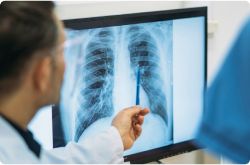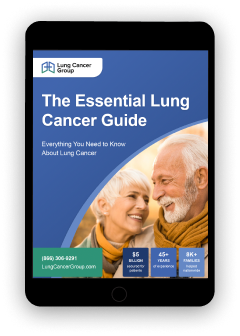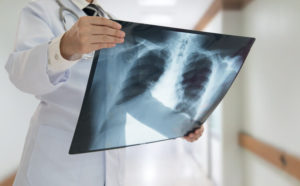Lung Cancer
Lung cancer is the second most common type of cancer in the United States. Roughly 226,650 people are estimated to develop lung cancer in 2025, according to the American Cancer Society. Smoking is the main cause of lung cancer, but asbestos exposure can also put you at risk. We can potentially help you access compensation for lung cancer — get started now.
What Is Lung Cancer?

Lung cancer forms when cells in lung tissue mutate and divide at out-of-control rates.
If lung cancer tumors spread throughout the body, they can cause major organs to shut down and lead to fatal outcomes.
Lung Cancer Quick Facts
- Causes: You could develop lung cancer if you smoke or breathe in cancer-causing substances like asbestos.
- Symptoms: Common symptoms include coughing, shortness of breath, and chest pain.
- Risk factors: A family history of asbestos exposure, lung cancer, or pre-existing health problems can put you at risk.
- Types: Non-small cell lung cancer (NSCLC) and small cell lung cancer (SCLC) are the two main types.
- Treatments: You may be able to beat lung cancer with treatments like surgery, chemotherapy, immunotherapy, and radiation.
- Survival: Lung cancer life expectancy ranges from 8-23 months, but some patients live for decades.
Lung Cancer Group can walk with you through your lung cancer journey and help you access financial compensation for health care costs and other expenses if eligible.
Get our Free Lung Cancer Guide to see all the ways we can assist you.

- Understand risk factors
- Find top treatments
- Pursue compensation




Causes of Lung Cancer
There are several possible causes of lung cancer, most notably cigarette smoke and asbestos exposure. Learn about common lung cancer causes below.
Smoking
Smoking is the main cause of lung cancer. Cigarette smoking causes 80-90% of all lung cancer deaths in the United States, according to the Centers for Disease Control and Prevention (CDC).
Smoke from cigarettes and other tobacco products contains thousands of toxins. These toxins can damage lung cells and cause mutations that lead to cancer.
Secondhand Smoke
You may have been exposed to secondhand smoke if a loved one smoked. Over 4,100 people die every year from lung cancer caused by secondhand smoke, according to the American Lung Association (ALA).
Lung Cancer and Asbestos
Asbestos is a mineral made up of tiny fibers. If you inhale the fibers, they can get stuck in your lungs and cause cancer 10-50 years later.
Over 27 million people were exposed to products made with asbestos between 1940 and 1979, and manufacturers hid the risks. As a result, thousands are diagnosed with asbestos-related diseases like lung cancer and mesothelioma each year.
You may be able to pursue compensation from manufacturers if you have lung cancer from asbestos. Call (877) 446-5767 now to get started.
Radon
Radon is the second-most common cause of lung cancer. Radon is a gas with no color or odor that naturally forms as radioactive materials in the earth break down.
The U.S. Environmental Protection Agency (EPA) notes that radon is the main cause of lung cancer in nonsmokers. The American Cancer Society (ACS) found that those who smoked cigarettes and were exposed to radon had a greater risk of lung cancer.
Lung Cancer Risk Factors
Many factors could put you at risk of lung cancer besides smoking, asbestos, and radon.
Lung cancer risk factors include:
- Air pollution: You can develop lung cancer if the air outside is filled with toxic chemicals. Vehicles, power plants, and fires can release cancer-causing substances into the air.
- Family history of lung cancer: You’re at a higher risk if family members were diagnosed, as you may have been exposed to carcinogenic materials or have a genetic risk.
- HIV infections: HIV weakens the body’s ability to fight cancer. Those with HIV or AIDS are at a higher risk of lung cancer even if they don’t smoke.
- Pre-existing lung diseases: Asthma, chronic obstructive pulmonary disease (COPD), and tuberculosis can put you at risk of lung cancer, according to a report from the medical journal Medicine.
Talk to your doctor if you’re worried about lung cancer. Doctors may recommend regular lung cancer screenings if you may be at risk.
Lung cancer is the second-most common type of cancer in the United States. Common causes include smoking and asbestos exposure. If you have lung cancer, we may be able to help you understand your treatment options and pursue compensation.
Duration: 1 min 20 sec
Lung Cancer Symptoms
Lung cancer usually doesn’t cause any symptoms until it has started to spread. More symptoms may appear as the cancer reaches other parts of the body.
Symptoms and signs of lung cancer include:
- A cough that won’t go away
- Bloody sputum (coughed-up mucus)
- Chest pain
- Fatigue
- Shortness of breath
- Weight loss
Symptoms of advanced lung cancer include bone pain, headache, and swelling of lymph nodes.
See a doctor right away if you have symptoms of lung cancer. Doctors can take steps to confirm if your symptoms are related to lung cancer and recommend treatments.
Get our Free Lung Cancer Guide to learn how we can help if you were exposed to asbestos and now have lung cancer.




- Understand risk factors
- Find top treatments
- Pursue compensation




Lung Cancer Diagnosis
Doctors use several tests to diagnose lung cancer. First, they will look at your medical history and if you or a loved one smoked or worked around asbestos.
Then, they’ll perform a physical exam to check for lung cancer symptoms and order imaging tests to look in your lungs for tumors.


Lung cancer imaging tests include:
- Chest X-ray: This uses a low dose of radiation to take a picture of the inside of your lungs. It is usually the first scan doctors perform if they think you may have lung cancer, according to the ACS.
- CT (computed tomography) scan: CT scans are like X-rays but more detailed. Mayo Clinic notes that CT scans often show tumors in lungs that weren’t found on X-rays.
- Magnetic Resonance Imaging (MRI) scan: MRIs use radio waves to make images. They may be recommended if doctors think lung cancer has spread to your spine or brain, according to the ACS.
- Positron Emission Tomography (PET) scan: You’ll be injected with a safe, low-dose radioactive material. It will spread into your body and attach to cells so doctors can more easily find cancer tumors.
If your doctors think you have lung cancer after the scans, they will order a biopsy. This is the only way to confirm your diagnosis. It involves removing a fluid or tissue sample for review under a microscope to see if cancer cells are present.
Lung Cancer Screening
Mayo Clinic recommends undergoing lung cancer screenings each year if you’re at risk. Doctors take imaging scans of your lungs to check for signs of cancer during a screening.
The U.S. Preventive Services Task Force suggests getting screened if you:
- Are between the ages of 50 and 80
- Currently smoke
- Quit smoking less than 15 years ago
- Smoked 1 or more packs of cigarettes per day for 20+ years
A screening can help doctors diagnose lung cancer before symptoms appear. This is important as the cancer usually hasn’t spread far at that point, making it easier to treat.
Types of Lung Cancer
There are two main types of lung cancer: small cell lung cancer (SCLC) and non-small cell lung cancer (NSCLC). Doctors can determine which type you have during a biopsy.
Learn about the different types of lung cancer below.
Non-Small Cell Lung Cancer
Non-small cell lung cancer is the most common type, making up 80-85% of all cases, according to the ACS. While it’s aggressive, patients can often receive treatments like surgery to hopefully live longer.
A notable subtype is adenocarcinoma, which is the leading cause of cancer-related mortality, according to the U.S. National Library of Medicine. Treatments can still help many adenocarcinoma lung cancer patients improve their survival time.
Small Cell Lung Cancer
Small cell lung cancer is a less common type, making up 10-15% of cases. The cells are smaller than NSCLC cells and spread quickly, making it more aggressive, according to Cleveland Clinic.
Doctors typically treat small cell lung cancer tumors using chemotherapy, immunotherapy, and radiation.
Bronchial Carcinoids
Bronchial carcinoids are the third and least common type of lung cancer, making up just 1-2% of cases.
This type is often easy to treat, and most patients can live for many years with prompt medical care.
Asbestos Lung Cancer
You could develop any type of lung cancer listed above from asbestos exposure — even if you smoked. Asbestos fibers can worsen the damage caused by smoking and increase your cancer risk.
Manufacturers of asbestos-containing products knew the material was harmful but told no one for decades. Get a free case review to find out if you may qualify for compensation from these companies.
- Access Financial Aid and Justice
- Learn About Your Options
- Contact Us for Free



Lung Cancer Staging
Doctors classify lung cancer cases into stages during a diagnosis to note the cancer’s spread (metastasis) and determine the best treatment plan.
The stages of lung cancer vary depending on which type you have.
There are five stages of NSCLC:
![]()
Stage 0
Cancer is on the top layer of the lung and is easily treated.
![]()
Stage 1
A small cancer tumor has formed in the lung.
![]()
Stage 2
Tumors are larger than stage 1 and have spread into lymph nodes.
![]()
Stage 3
Tumors have spread into more lymph nodes, the mediastinum (space in chest between lungs), and/or organs outside of the chest.
![]()
Stage 4
Tumors have spread through the body to the brain, heart, liver, or bones. Also known as metastatic lung cancer, it’s hard to treat, and patients have the lowest life expectancies.
Doctors have a two-stage system for diagnosing SCLC.
These stages are:
- Limited stage: Limited or early-stage cancer is contained to one side of the chest and can be treated with radiation.
- Extensive stage: The cancer has spread into the lungs and/or to the bones, brain, and other organs.
No matter which stage you’re in, doctors can recommend treatments to help you live as long as possible and improve your quality of life.
Lung Cancer Prognosis
A prognosis is your health outlook after being diagnosed with a disease. Generally, lung cancer patients only live 2 years or less, but some may survive for decades.
A lung cancer prognosis depends on factors like:
- Cancer type
- Overall health
- Stage
Doctors can tell you how long you’re projected to live (life expectancy) and how many other patients reached long-term survival (survival rate) as part of a prognosis.
“Many doctors and nurses recommend not getting too hung up on your lung cancer prognosis. It is better to conserve your energy and focus on your treatment by taking one day at a time.”
— American Lung Association (ALA)
Lung Cancer Life Expectancy
Non-small cell lung cancer patients have an average life expectancy of 11-13 months. Those with small-cell lung cancer typically live between 8 and 23 months, depending on their stage at the time of diagnosis.
That said, some lung cancer patients live for 20 years or more, becoming long-term survivors thanks to treatment.
Call (877) 446-5767 now to learn if you may qualify for lung cancer compensation to help you pay for potentially life-extending treatments.
Lung Cancer Survival Rate
The average 5-year survival rate for lung cancer patients is 28.4%, according to the ALA.
The 5-year survival rate is 64% if the cancer is diagnosed in an early stage. However, the 5-year survival rate drops to 9% in patients diagnosed after the cancer has spread.
Treatment for Lung Cancer
Lung cancer treatments can potentially help you live longer and improve your quality of life. Learn about the most common treatment options for lung cancer below.
Surgery
Oncology (cancer) doctors can remove tumors from the lungs and chest wall with different surgeries. Part or all of the lung may also be surgically removed, according to the National Cancer Institute (NCI).
Generally, doctors can only perform a major lung cancer surgery if you’re an early-stage cancer patient. Surgery isn’t often recommended for late-stage lung cancer, but other treatments could still help you achieve long-term survival.
Chemotherapy
Chemotherapy is medication that destroys cancer. Different chemotherapy regimens can be used alongside surgery, immunotherapy, and radiation to treat lung cancer at any stage, according to the ACS.
Get a Free Lung Cancer Guide to learn about how you may be able to access and afford chemotherapy and other lung cancer treatments.




- Understand risk factors
- Find top treatments
- Pursue compensation




Radiation
Doctors can use beams of energy to destroy cancer cells. Known as radiation therapy, it may be used to shrink tumors so doctors can surgically remove them or with chemotherapy to treat late-stage cancer.
Your cancer care team may also use radiation to prevent lung tumors from spreading to other body parts, like the brain.
Immunotherapy
Lung cancer cells can sometimes avoid being attacked by your immune system. Lung cancer immunotherapy drugs help your body’s immune system more easily find malignant cells and tumors.
Doctors may combine immunotherapy with other treatments like chemotherapy to kill as much of the cancer as possible.
Other Lung Cancer Treatment Options
There are many other lung cancer treatments beyond the ones listed above.
Additional lung cancer treatments include:
- Alternative treatments: Yoga, meditation, supplements, and more may ease cancer symptoms. However, they are not medically proven to help you beat lung cancer. Talk to your doctor before starting an alternative treatment.
- Clinical trials: These studies allow researchers to test new treatments on patients. Ask your doctor about clinical trials you may qualify for if you are interested.
- Palliative care: Palliative care eases painful symptoms of lung cancer. Minor surgeries and low doses of chemotherapy and radiation can all be used.
- Radiofrequency ablation: This treatment uses electricity to destroy cancer cells.
- Targeted therapies: These shrink tumors by attacking the DNA of lung cancer cells.
For best results, work with your medical team to develop a lung cancer treatment plan that is best for your case.
Lung Cancer Survivors


Treatments have helped many lung cancer patients outlive their original prognosis by years or decades. These patients are called lung cancer survivors.
It is possible to achieve long-term survival even if you’re diagnosed with late-stage lung cancer.
Notable survivors of lung cancer include:
- Deborah: Despite quitting smoking, Deborah was diagnosed with lung cancer three separate times. Initially diagnosed in 2013, she has received radiation therapy in each case to live longer.
- Keegan: Diagnosed with stage 4 lung cancer in 2022, Keegan is cancer-free today thanks to targeted therapy and surgery. He has “no evidence of disease,” which means doctors can’t find any trace of the cancer in his body.
- Terry: Following a diagnosis of stage 3 lung cancer, Terry underwent lung-removal surgery and radiation, allowing her to become a 15-year survivor.
As lung cancer research continues and new treatments are developed, more patients may be able to become survivors.
“The standard of care for lung cancer treatment has changed just in the last five years, due to advances in clinical research that our patients have contributed to. There is real hope in the field that we are able to improve and extend patients’ lives.”
— Dr. Anne Chiang, Lung Oncologist at Yale Medicine
Compensation for Lung Cancer Patients
If you or a loved one was exposed to asbestos, you may qualify for lung cancer compensation to help cover expenses that stem from your diagnosis.
It’s important to explore your options to compensate for medical expenses, lost wages, or the costs of potentially traveling to get treatment.
Here are past lung cancer payouts our legal partners have secured:
- $3 million to a Missouri woman
- $2 million to a California construction worker
- $2 million to a New York railroad worker
- $1.95 million to a Colorado man
- $1.57 million to a Nevada veteran
- $1.57 million to a California plumber
- $2.18 million to an Illinois electrician
- $2.77 million to a Tennessee pipefitter
If you’re eligible, Lung Cancer Group can help you access maximum compensation in the shortest amount of time. We have partnered with top lung cancer law firms that may be able to pursue payouts on your behalf.
Learn more with a free case review.
- Access Financial Aid and Justice
- Learn About Your Options
- Contact Us for Free



Get Help from Lung Cancer Group Now
A lung cancer diagnosis can be stressful, but you don’t have to go through it alone. Our team can walk with you through your lung cancer journey so you can get the support you deserve.
Lung Cancer Group can help you:
- Better understand your treatment options
- Determine if asbestos caused your cancer
- Navigate life after being diagnosed
- Pursue asbestos lung cancer compensation
Don’t wait: Call (877) 446-5767 or get our Free Lung Cancer Guide to see how we can assist you or a loved one.
Lung Cancer FAQs
What is lung cancer?
Lung cancer is when mutated cells grow at out-of-control rates and form into tumors. The tumors usually start in the bronchus (one of the tubes allowing air into the lungs).
Lung cancer can spread throughout the body and cause fatal complications if left untreated.
The most common cause of lung cancer is smoking. Exposure to other toxins like asbestos can also lead to this disease.
What are the first signs of lung cancer?
The first signs of lung cancer include a cough that won’t go away and shortness of breath. If you’re experiencing these symptoms and smoked or suffered asbestos exposure, see a doctor immediately and tell them you’re worried about lung cancer.
By addressing possible lung cancer symptoms early on, you can access treatments that may potentially extend your life.
Is mesothelioma a type of lung cancer?
No, mesothelioma is not a type of lung cancer, though both can be caused by asbestos exposure. Mesothelioma is a cancer that forms in the lining of major organs, most commonly the lung lining (pleura).
Our team can help you pursue compensation for mesothelioma or asbestos lung cancer. Call (877) 446-5767 now to start the process if eligible.
How long does a person live with lung cancer?
The average life expectancy for lung cancer is 8-23 months, but it may be possible to live for 20 years or more after a diagnosis.
You have a better chance of being cured or living longer if you’re diagnosed with early-stage lung cancer and get prompt medical care.
Can you live a good life with lung cancer?
Yes, you may be able to live a good life with lung cancer, especially if it’s diagnosed early on.
Between 80% and 90% of patients with early-stage small cell lung cancer can be cured, according to Lurie Cancer Center.
Experienced lung cancer doctors can help you work toward being cured or entering remission (where you’ll have fewer or no symptoms). Lung cancer can quickly be fatal without treatment.
What are the signs of end-stage lung cancer?
Signs of end-stage lung cancer include:
- A chronic, long-term cough
- Chest and bone pain
- Headache
- Shortness of breath
Weight loss
Some symptoms (such as chest pain) may have appeared earlier but have worsened.
Get screened if you’re at risk of lung cancer, and see a doctor if you notice any of the warning signs listed above.
How fast can lung cancer spread?
Lung cancer can spread very rapidly through your body, especially without treatment. Treatments can slow the cancer down so you can live longer or even be fully cured.
Is compensation available if I developed lung cancer?
Yes. You may qualify for compensation for lung cancer if you were exposed to asbestos. Our partner lung cancer lawyers have secured millions of dollars in some cases for other patients.
Chat with us now to find out if you can pursue lung cancer compensation.
Is non-small cell lung cancer caused by asbestos?
Yes, non-small cell lung cancer (NSCLC) can be caused by asbestos. If you or someone you love worked with or around asbestos-containing materials, it could lead to NSCLC or another type of lung cancer later in life.
How can I access lung cancer treatments?
Doctors at top lung cancer centers can make sure you’re getting the best treatments possible. By working with them, you have a better chance of living longer or even being cured.
Get our Free Lung Cancer Guide now to learn about treatments that can help you.
Is lung cancer curable?
Yes, lung cancer is sometimes curable if it’s diagnosed and treated in an early stage before it has spread.
While there’s no uniform cure for every lung cancer case, some early-stage patients can reach a point where there’s no evidence of disease in their body. These patients can live much longer, with many going on to live full lives despite a lung cancer diagnosis.







